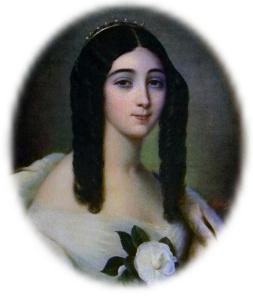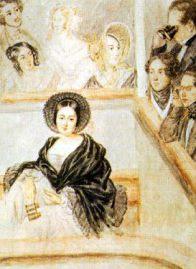[She was] the most elegant of women, having the most aristocratic taste and the most exquisite tact: she set the tone for a whole area of society. - from her obituary
 As we have seen before, it’s not unusual for the lives of whores to become the stuff of legend, often to the point where the real woman is either lost under the embellishment or people forget there was ever a real woman in the first place. Such a woman was Marie Duplessis, whose real story was far more interesting than the romantic legend later created from it. She was born Alphonsine Plessis on January 15th, 1824 to a ne’er-do-well Norman father and a mother who was the last of an impoverished noble family which had been reduced to servility; her mother died when she was six and her father raised her alone until she was fourteen, when he sold her to a band of gypsies. Yes, this is her actual story, stranger than the fiction by which most modern people know her, and as you will see it only gets better.
As we have seen before, it’s not unusual for the lives of whores to become the stuff of legend, often to the point where the real woman is either lost under the embellishment or people forget there was ever a real woman in the first place. Such a woman was Marie Duplessis, whose real story was far more interesting than the romantic legend later created from it. She was born Alphonsine Plessis on January 15th, 1824 to a ne’er-do-well Norman father and a mother who was the last of an impoverished noble family which had been reduced to servility; her mother died when she was six and her father raised her alone until she was fourteen, when he sold her to a band of gypsies. Yes, this is her actual story, stranger than the fiction by which most modern people know her, and as you will see it only gets better.
The gypsies took her to Paris and put her to work in a dress shop, but by fifteen she discovered that prostitution was far more lucrative and allowed her to pay off her indenture in less than a year (many “trafficked” women still make the same choice for exactly the same reason today). Her exceptional beauty and charm won her a devoted following, and at 16 she attracted her first important client: Agénor de Guiche, later one of Napoleon III’s ministers. It was at this time she took the name Marie Duplessis (the “Du” prefix connotes a noble family, an honor she felt her mother’s ancestry entitled her to) and wisely invested in tutors who taught her not only to read and write, but also educated her in history, geography and other subjects she needed to converse intelligently with men of the ruling class. By the age of 17 she was involved with Comte Edouard de Perregaux, but because he could not give her all she needed she did not devote herself to him exclusively; another patron, the Count Von Stakelberg (a Swedish diplomat in his eighties) bought her a house in the Boulevard de la Madeleine.
 Like so many other courtesans, she established a salon in her residence, and many of the Parisian cognoscenti gathered there; among them was Alexandre Dumas fils, the as-yet-undistinguished son of the famed adventure novelist. The two fell in love in September of 1844 (only a few months after the publication of his father’s most famous work, The Three Musketeers), but the relationship was not to be; Dumas was far too poor to support her, and by August of 1845 she had had quite enough of his jealousy toward those who could. But as we will see, the relationship actually worked in reverse, and Marie brought Dumas far more wealth than he ever gave her. Her next lover was the famous composer (and infamous womanizer) Franz Liszt, but by spring of 1846 he had moved on and she entered into a marriage of convenience with Perregaux. Because this was an English registry-office marriage transacted without benefit of clergy it was not considered binding in France, which suited Marie just fine: she could share her husband’s title without having to observe any of the restrictions that come with matrimony.
Like so many other courtesans, she established a salon in her residence, and many of the Parisian cognoscenti gathered there; among them was Alexandre Dumas fils, the as-yet-undistinguished son of the famed adventure novelist. The two fell in love in September of 1844 (only a few months after the publication of his father’s most famous work, The Three Musketeers), but the relationship was not to be; Dumas was far too poor to support her, and by August of 1845 she had had quite enough of his jealousy toward those who could. But as we will see, the relationship actually worked in reverse, and Marie brought Dumas far more wealth than he ever gave her. Her next lover was the famous composer (and infamous womanizer) Franz Liszt, but by spring of 1846 he had moved on and she entered into a marriage of convenience with Perregaux. Because this was an English registry-office marriage transacted without benefit of clergy it was not considered binding in France, which suited Marie just fine: she could share her husband’s title without having to observe any of the restrictions that come with matrimony.
Her brilliant career was not to last, however; like so many 19th-century children of poverty she had contracted tuberculosis (or as it was called in those days, “consumption”), and by the summer of 1846 she knew she was dying. She visited every specialist in Europe, but there was no cure. By September she was no longer able to work, and none of the clients who eulogized her after her death did anything to ease her suffering; as Nickie Roberts wrote in Whores in History, she was “abandoned by all her former lovers and friends except her faithful maid Clothilde – and her creditors.” She died on February 3rd, 1847, less than three weeks after her 23rd birthday. And though her lavish funeral (paid for by Perregaux and Von Stakelberg) was attended by hundreds, her possessions still had to be auctioned off to pay her debts.
 That was the real story: a motherless young woman, “trafficked” at 14, who paid for her own education and became one of the most successful members of her profession at an age when modern women are still called “children”, then died of an incurable malady which would have claimed her no matter what because antibiotics had not yet been invented. But a spurned lover decided to twist that into a morality play, making Marie – or as he renamed her, “Marguerite Gautier” – a “fallen woman” who dies young as a result of her dissolute life; he also created a fictional version of himself named “Armand Duval”, who convinces her to give up her life as a courtesan and thus saves her “virtue” before she dies. The lover was of course Alexandre Dumas fils, and the novel was La Dame aux Camelias (“The Lady of the Camellias”), published only a year after Marie’s death. It soon made him far wealthier than she ever was; it became a bestseller, then an extremely popular play, then in 1853 a Verdi opera named La Traviata (“The Fallen Woman”). The book has remained constantly in print since then, the play and opera have been performed innumerable times, and there have been three different ballets and a dozen movie adaptations (the most famous being Camille (1936), with Greta Garbo as “Marguerite”). I’m sure most of you have seen or at least heard of one or more of these fictional representations of Marie Duplessis (especially if you read Tuesday’s column), yet I doubt more than a few of you – if any at all – knew anything of her real story before today. Some things never change: today, as in the 19th century, most people prefer to embrace romantic nonsense about “fallen women” and how awful it is to be a whore, than to recognize the simple, unvarnished truth.
That was the real story: a motherless young woman, “trafficked” at 14, who paid for her own education and became one of the most successful members of her profession at an age when modern women are still called “children”, then died of an incurable malady which would have claimed her no matter what because antibiotics had not yet been invented. But a spurned lover decided to twist that into a morality play, making Marie – or as he renamed her, “Marguerite Gautier” – a “fallen woman” who dies young as a result of her dissolute life; he also created a fictional version of himself named “Armand Duval”, who convinces her to give up her life as a courtesan and thus saves her “virtue” before she dies. The lover was of course Alexandre Dumas fils, and the novel was La Dame aux Camelias (“The Lady of the Camellias”), published only a year after Marie’s death. It soon made him far wealthier than she ever was; it became a bestseller, then an extremely popular play, then in 1853 a Verdi opera named La Traviata (“The Fallen Woman”). The book has remained constantly in print since then, the play and opera have been performed innumerable times, and there have been three different ballets and a dozen movie adaptations (the most famous being Camille (1936), with Greta Garbo as “Marguerite”). I’m sure most of you have seen or at least heard of one or more of these fictional representations of Marie Duplessis (especially if you read Tuesday’s column), yet I doubt more than a few of you – if any at all – knew anything of her real story before today. Some things never change: today, as in the 19th century, most people prefer to embrace romantic nonsense about “fallen women” and how awful it is to be a whore, than to recognize the simple, unvarnished truth.

posted on 10 September at 21:37
http://www.vulcanoad.com.br/como-clarear-os-dentes-com-clareamento-dental-caseiro/ clareamento dental